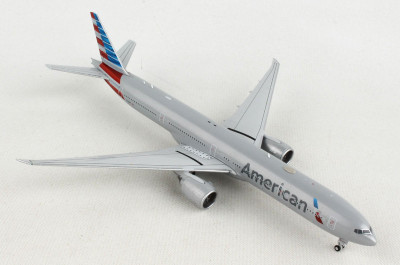The Boeing 777, commonly referred to as the Triple Seven, is an American wide-body airliner developed and manufactured by Boeing Commercial Airplanes. It is the world's largest twinjet. The 777 was designed to bridge the gap between Boeing's 767 and 747, and to replace older DC-10s and L-1011s. Developed in consultation with eight major airlines, with a first meeting in January 1990, the program was launched on October 14, 1990 with an order from United Airlines. The prototype was rolled out on April 9, 1994, and first flew on June 12, 1994. The 777 entered service with the launch customer, United Airlines, on June 7, 1995. Longer range variants were launched on February 29, 2000 and were first delivered on April 29, 2004.
It can accommodate a ten–abreast seating layout and has a typical 3-class capacity of 301 to 368 passengers, with a range of 5,240 to 8,555 nautical miles (9,700 to 15,840 km). It is recognizable for its large-diameter turbofan engines, six wheels on each main landing gear, fully circular fuselage cross-section, and a blade-shaped tail cone. It is the first Boeing aircraft with fly-by-wire controls. It initially competed with the Airbus A340 and the McDonnell Douglas MD-11, both now out of production, and as of 2021 competes with the Airbus A350 XWB and A330-900.
The 777-300ER ("ER" for Extended Range) is the B-market version of the -300. Its higher MTOW and increased fuel capacity permits a maximum range of 7,370 nautical miles (13,650 km) with 396 passengers in a two-class seating arrangement. The 777-300ER features raked and extended wingtips, a strengthened fuselage and wings and a modified main landing gear. Its wings have an aspect ratio of 9.0. It is powered by the GE90-115B turbofan, the world's most powerful jet engine with a maximum thrust of 115,300 lbf (513 kN).
Following flight testing, aerodynamic refinements have reduced fuel burn by an additional 1.4%. At Mach 0.839 (495 kn; 916 km/h), FL300, -59 °C and at a 513,400 lb (232.9 t) weight, it burns 17,300 lb (7.8 t) of fuel per hour. Its operating empty weight is 371,600 lb (168.6 t). The projected operational empty weight is 168,560 kg (371,610 lb) in airline configuration, at a weight of 216,370 kg (477,010 lb) and FL350, total fuel flow is 6,790 kg/h (14,960 lb/h) at M0.84/472 kn (874 km/h), rising to 8,890 kg (19,600 lb)/h at M0.87/506 kn (937 km/h).
Since its launch, the -300ER has been a primary driver of the twinjet's sales past the rival A330/340 series. Its direct competitors have included the Airbus A340-600 and the A350-1000. Using two engines produces a typical operating cost advantage of around 8–9% for the -300ER over the A340-600.[199] Several airlines have acquired the -300ER as a 747-400 replacement amid rising fuel prices given its 20% fuel burn advantage.The -300ER has an operating cost of US$44 per seat hour, compared to an Airbus A380's roughly US$50 per seat hour (hourly cost is about US$26,000), and US$90 per seat hour for a Boeing 747-400 as of 2015.

















